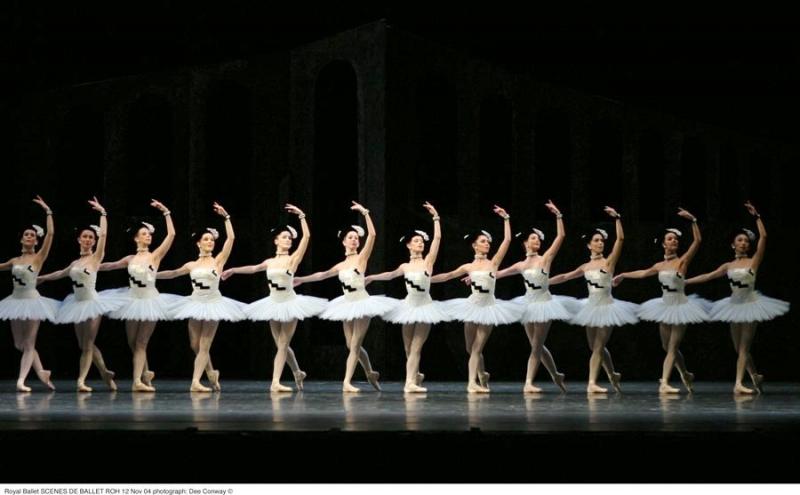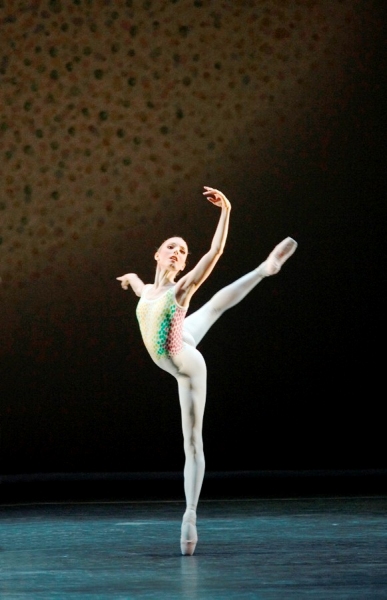Scènes de Ballet/ Voluntaries/ The Rite of Spring, Royal Ballet | reviews, news & interviews
Scènes de Ballet/ Voluntaries/ The Rite of Spring, Royal Ballet
Scènes de Ballet/ Voluntaries/ The Rite of Spring, Royal Ballet
The mixed bill is a mixed bag: some good, and some downright embarrassing

Programming a mixed bill is a very delicate art, and what seems like an interesting mix to one person might appear to be an entirely random series of choices to another. The Royal’s new triple is the perfect example.
Scènes de Ballet is a formidable undertaking. The ballet as a whole is like a chillingly beautiful woman: entirely, self-sufficiently aware of her beauty, she doesn't trouble to charm or entice. We can take her or leave her, and either way, she is remotely, coolly indifferent, like the moon.
On a more practical level, Ashton made the piece as an examination of angles: the corps, the soloists, all “read” as pieces of geometry. Further, each dancer is expected to epitomise angles individually, by using épaulement, the placement of head and shoulders, to clarify and extend the dimension and position in which the dancer stands in relation to the audience.
That’s the theory. In practice this afternoon, some of the dancers understood and shaped their performances – Sergei Polunin, producing yet another elegantly defined role – and others didn’t.
Lauren Cuthbertson, in the lead, has added numerous roles to her repertoire in the last year. In some she has been formidable – she was a ferocious, driving, urgent force in Balanchine’s Serenade, and a sweetly pretty Alice in Christopher Wheeldon’s Alice in Wonderland. But in others she has appeared rushed and flustered, whereupon her style reverts to that of a competent soloist.
The steps were there, but the detail was smudged. One passage is a series of bourées, a small lift in passé, and, simultaneously, the hands flick over from palms up to palms down. Nothing complex, but her hand shift had no weight, was almost invisible – and it is that flick that counterpoints Stravinsky’s chic little rhythm and drives home what Ashton is doing.
 Voluntaries was created by Glen Tetley for the Stuttgart Ballet in 1973, immediately after the death of its director, John Cranko, and it inevitably carries an elegiac air, not only for Cranko, but for the memorable partnership of Marcia Haydée and Richard Cragun. The pairing of Leanne Benjamin with newcomer Nehemiah Kish, who appears to be at least 30cm taller than his minute partner, is perhaps not destined to be as memorable. Benjamin, a focused, dramatic performer, seemed uncomfortable; Kish, with his great height and large body, is perhaps not suited for Tetley’s sleek, fleet choreography.
Voluntaries was created by Glen Tetley for the Stuttgart Ballet in 1973, immediately after the death of its director, John Cranko, and it inevitably carries an elegiac air, not only for Cranko, but for the memorable partnership of Marcia Haydée and Richard Cragun. The pairing of Leanne Benjamin with newcomer Nehemiah Kish, who appears to be at least 30cm taller than his minute partner, is perhaps not destined to be as memorable. Benjamin, a focused, dramatic performer, seemed uncomfortable; Kish, with his great height and large body, is perhaps not suited for Tetley’s sleek, fleet choreography.
By contrast the trio, often a high point of this piece, featured the steel-sprung joints of Sarah Lamb (pictured right, © Bill Cooper), as well as the delightfully buoyant and well-paired Ryoichi Hirano and Valeri Hristov (standing in immaculately for an indisposed Thiago Soares), both of whom seemed to revel in Tetley's slippery river of steps.
And best of all was the splendid organ-playing of Thomas Trotter: kudos to the Royal Ballet for this invitation to an outstanding musician.
That was the good news. The bad news is Macmillan’s Rite of Spring. Macmillan created the piece in 1962, using Sidney Nolan’s aboriginal-inspired sets and costumes, and developing a generic, simplified “primitive” vocabulary. On an aesthetic level the piece is a nursery version of Nijinska’s Les noces, without either her rhythmic sophistication or her ability to encompass pity and terror. On a sociological - or human - level, what might have been acceptable, even unnoticeable, in 1962, is not so in 2011: the piece, at best, describes an aboriginal people and culture in unpleasantly reductionist, stereotypical terms. It is past time to put it to rest.
Explore topics
Share this article
Add comment
The future of Arts Journalism
You can stop theartsdesk.com closing!
We urgently need financing to survive. Our fundraising drive has thus far raised £33,000 but we need to reach £100,000 or we will be forced to close. Please contribute here: https://gofund.me/c3f6033d
And if you can forward this information to anyone who might assist, we’d be grateful.

Subscribe to theartsdesk.com
Thank you for continuing to read our work on theartsdesk.com. For unlimited access to every article in its entirety, including our archive of more than 15,000 pieces, we're asking for £5 per month or £40 per year. We feel it's a very good deal, and hope you do too.
To take a subscription now simply click here.
And if you're looking for that extra gift for a friend or family member, why not treat them to a theartsdesk.com gift subscription?
more Dance
 Help to give theartsdesk a future!
Support our GoFundMe appeal
Help to give theartsdesk a future!
Support our GoFundMe appeal
 Ballet to Broadway: Wheeldon Works, Royal Ballet review - the impressive range and reach of Christopher Wheeldon's craft
The title says it: as dancemaker, as creative magnet, the man clearly works his socks off
Ballet to Broadway: Wheeldon Works, Royal Ballet review - the impressive range and reach of Christopher Wheeldon's craft
The title says it: as dancemaker, as creative magnet, the man clearly works his socks off
 The Forsythe Programme, English National Ballet review - brains, beauty and bravura
Once again the veteran choreographer and maverick William Forsythe raises ENB's game
The Forsythe Programme, English National Ballet review - brains, beauty and bravura
Once again the veteran choreographer and maverick William Forsythe raises ENB's game
 Sad Book, Hackney Empire review - What we feel, what we show, and the many ways we deal with sadness
A book about navigating grief feeds into unusual and compelling dance theatre
Sad Book, Hackney Empire review - What we feel, what we show, and the many ways we deal with sadness
A book about navigating grief feeds into unusual and compelling dance theatre
 Balanchine: Three Signature Works, Royal Ballet review - exuberant, joyful, exhilarating
A triumphant triple bill
Balanchine: Three Signature Works, Royal Ballet review - exuberant, joyful, exhilarating
A triumphant triple bill
 Romeo and Juliet, Royal Ballet review - Shakespeare without the words, with music to die for
Kenneth MacMillan's first and best-loved masterpiece turns 60
Romeo and Juliet, Royal Ballet review - Shakespeare without the words, with music to die for
Kenneth MacMillan's first and best-loved masterpiece turns 60
 Vollmond, Tanztheater Wuppertal Pina Bausch + Terrain Boris Charmatz, Sadler's Wells review - clunkily-named company shows its lighter side
A new generation of dancers brings zest, humour and playfulness to late Bausch
Vollmond, Tanztheater Wuppertal Pina Bausch + Terrain Boris Charmatz, Sadler's Wells review - clunkily-named company shows its lighter side
A new generation of dancers brings zest, humour and playfulness to late Bausch
 Phaedra + Minotaur, Royal Ballet and Opera, Linbury Theatre review - a double dose of Greek myth
Opera and dance companies share a theme in this terse but affecting double bill
Phaedra + Minotaur, Royal Ballet and Opera, Linbury Theatre review - a double dose of Greek myth
Opera and dance companies share a theme in this terse but affecting double bill
 Onegin, Royal Ballet review - a poignant lesson about the perils of youth
John Cranko was the greatest choreographer British ballet never had. His masterpiece is now 60 years old
Onegin, Royal Ballet review - a poignant lesson about the perils of youth
John Cranko was the greatest choreographer British ballet never had. His masterpiece is now 60 years old
 Northern Ballet: Three Short Ballets, Linbury Theatre review - thrilling dancing in a mix of styles
The Leeds-based company act as impressively as they dance
Northern Ballet: Three Short Ballets, Linbury Theatre review - thrilling dancing in a mix of styles
The Leeds-based company act as impressively as they dance
 Best of 2024: Dance
It was a year for visiting past glories, but not for new ones
Best of 2024: Dance
It was a year for visiting past glories, but not for new ones

Comments
...
...